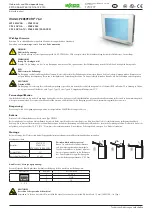
MicroBlaster MB1005
Section 3: Using the MicroBlaster
Comco Inc.
3-15
Issue Date: September 2003
Power Up
1. Switch "Power" to the "ON" position. The Power indicator should light.
2. Check to see that no air is escaping from the tank cover. If a leak is discovered,
follow the “Stopping-Refilling the Tank” procedure presented later in this section.
3.
Adjust the “Powder Flow” knob to “MAX” (fully clockwise).
4. Adjust the "Air Pressure" knob as necessary until the needle on the pressure gage is
centered at about 100 psi. Turning the knob clockwise raises the pressure. If the
needle indicates a higher operating pressure than desired, it will not lower as the
knob is turned counterclockwise, until the footswitch is depressed and air is flowing
from the handpiece.
Blasting
1. Place the work piece in the workstation. The window will provide a suitable
transparent barrier
between the operator’s face and the work piece to prevent flying
abrasive particles from entering the eyes, nose, or mouth.
2. Turn on the dust collector that is connected to the workstation.
3. Install the appropriate nozzle in the handpiece, being sure that the O-ring is in place,
and firmly seat the nozzle finger tight. The machine is initially equipped with a 0.030"
diameter nozzle (green), which is suitable for most abrasives and cutting purposes.
4. Make sure the handpiece is inserted into the workstation through one of the side
openings. Grasp it firmly as if it were a pencil, aiming the tip of the nozzle at the
work piece. The tip should be about 1/4" to 1/2" away from the surface to be blasted
(optimum distance for cutting is 5-8 times the nozzle outlet diameter).
CAUTION:
The air that comes out of the nozzle contains abrasive. Do
not point the nozzle at anything that could be harmed or
damaged as a result of abrasive flow, especially the
workstation glass window.
5. Step on the footswitch to start blasting. The abrasive pinch valve will open and the
modulator will start to hum. Abrasive will continue to flow as long as the footswitch is
pressed. Move the handpiece or the work piece as required by the job.
6. If more or less abrasion is desired, turn the "Air Pressure" knob to raise or lower the
pressure as abrasive is flowing.
7. To change cutting speed, type of cut, or surface finish produced, experiment with
nozzle distance and angle of the nozzle with respect to the surface of the work piece.
Refer to Table 3-1 and the beginning of this section for factors that affect abrasive
blasting results.
Summary of Contents for MB1005-1
Page 10: ......















































